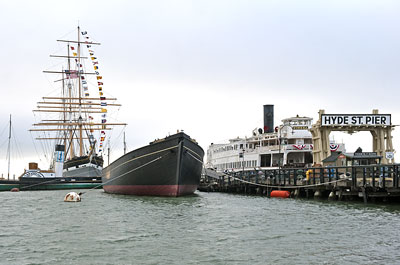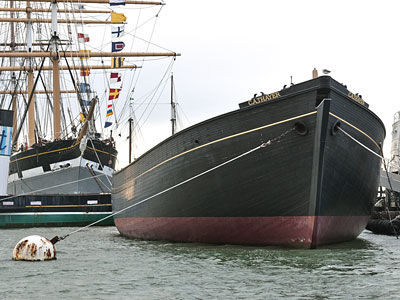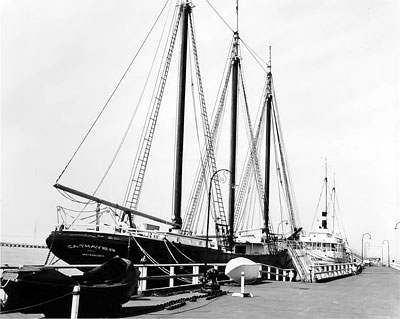National Register of Historic Places in San Francisco
 Historic Ships at the Hyde Street Pier
Historic Ships at the Hyde Street Pier
Eppleton Hall Steam Paddlewheel Tugboat
Balclutha Square Rigger
C. A. Thayer Lumber Schooner
Eureka Steam Ferryboat
 In 2004, C.A. Thayer was towed to Alameda for major restoration. Approximately 80% of her timbers were replaced with new timbers matching the original wood.
She was towed back to the Hyde Street Pier on April 12, 2007. When this photograph was taken, she was still missing her masts and bowsprit.
In 2004, C.A. Thayer was towed to Alameda for major restoration. Approximately 80% of her timbers were replaced with new timbers matching the original wood.
She was towed back to the Hyde Street Pier on April 12, 2007. When this photograph was taken, she was still missing her masts and bowsprit.
Above Photos 4 July 2010
C.A. Thayer Lumber Schooner
Hyde Street Pier
Built 1895
C. A. Thayer is the lone survivor of 122 sailing schooners designed in the 19th century for Pacific Coast lumber trade.
She was built in 1895 of native Douglas fir by Hans Ditley Bendixsen at Fairhaven, on Humboldt Bay. She was named for Clarence A. Thayer, secretary of the E. K. Wood Lumber Company, of San Francisco. The E. K. Wood Company was managing owner of the vessel.
For many years the only practicable way to ship the lumber products of the northern California redwood forests was by sea, and most of the sawmills were built on or very near the coast.
Fogs, strong winds, rocks, and powerful currents plagued the navigator, and most shipping points were mere dog-holes, slight indentations in a rocky coast, where ships had to anchor close to shore and load by chutes, lighters, or cables. These conditions quickly gave rise to a fleet of small sailing schooners capable of maneuvering in difficult locations that did yeomen service in the redwood lumber trade until gradually replaced by the steam schooner.
C.A. Thayer was large for a three-masted schooner, measuring 452 tons, with a length of 156', beam of 36' and 11' 8" depth of hold. Built with one hold which ran the length of the ship, she was designed to carry 575,000 board feet of lumber about half of it on deck. In later years, when she worked in the codfishing trade, a foc'sle was built in her hold. It still remains and encompasses approximately one quarter of the hold.
Designed primarily for coastwise work, C.A. Thayer regularly sailed from the Hoquiam, Washington mill of E. K. Wood Company to their yard at San Francisco or to Southern California; however, she made frequent offshore passages to carry lumber to Guaymas, Honolulu, and Fiji.
Like most of her sisters, C.A. Thayer was considered a good berth by seamen. The coastwise ships were notable feeders, and wages were $35.00 a month, a princely sum as compared to that offered by deepwater traders. Four able seamen, a carpenter or donkeyman, and the cook made up the normal crew. The afterguard consisted of two mates, the master and frequently the master's wife.
In 1912, C.A. Thayer was sold to Peter M. Nelson who owned a small salmon saltery on Bristol Bay, Alaska, 3,500 miles from San Francisco.
C.A. Thayer sailed from San Francisco every April for thirteen seasons, lay all summer in the anchorage of Squaw Creek or the Igushik River, and returned with the barrelled salmon during September. In the winter, she was laid up in Oakland Creek, and was repaired and refitted in preparation for the next voyage.
In 1925, C.A. Thayer was sold to the Pacific Coast Codfish Company which fished the Bering Sea. With the conclusion of the 1931 season, declining prices for salt cod led to laying up C.A. Thayer in Seattle for the rest of the decade.
The U. S. Army bought the decaying ship in 1942 for use as a barge in British Columbian and southeastern Alaskan waters. They cut her masts out, pumped money into her rotten stern, removed most of her deckhouse, and enlarged her hatches.
In 1945 the Army sold her back to Captain Shields for a pittance. Shields cannibalized three masts and a bowsprit from another schooner, and fitted them into C.A. Thayer making her ready for another five voyages to the Bering Sea. With her three masts transplanted from a topmast schooner without the topmasts, with iron extender bars making up the shortness of the shrouds, with her gaff foresail and main complemented by a leg-of-mutton mizzen, C.A. Thayer was one of the most unattractive three-masted schooners ever to sail from a Pacific port.
But the codfish didn't care, and C.A. Thayer sailed to the Bering Sea each season through 1950.
By this time the she was the last operating commercial schooner on the Pacific Coast - a genuine anachronism of the days when sail dominated the seas, when men worked half a year for a few hundred dollars, and when Americans ate salted cod.
By 1951, San Francisco had its first permanent maritime museum, and four years later, Balclutha lay in a berth at Fisherman's Wharf.
At the urging of the Maritime Museum, the California State Legislature appropriated $200,000 for the purchase and repair of a sailing schooner and a steam schooner. The need to move quickly was apparent. Of the once numerous coastwise lumber carriers, only two three-masted schooners and one steam schooner survived in repairable condition. And of the two sailing schooners, only C.A. Thayer could be purchased for a reasonable price.
By the end of 1956, the California State Division of Beaches and Parks had reached agreement on a purchase price for C.A. Thayer. Because she was in no condition to be towed from Seattle to San Francisco, she was repaired in Puget Sound shipyards - new stern, new rig, new masts - and although she was far short of restored, she was seaworthy and capable of a coastwise passage under her own sail.
After reaching San Francisco Bay, she was berthed at Jack London Square for over a year while options were considered.
In 1959, serious restoration of C.A. Thayer and Wapama began at a ship repair facility located at Oakland Dock & Warehouse Company's Pier 1-E.
Finally, in 1963, C.A. Thayer was moved to her present location at the Hyde Street Pier.
Excerpted from the NRHP Nomination Form.

C.A. Thayer is a National Historic Landmark.

Aquatic Park and Vicinity
- Pumping Station No. 2, Van Ness Avenue
- Aquatic Park Historic District
- Site of the First Ship into San Francisco Bay
- Ghirardelli Square, North Point at Larkin
- Haslett Warehouse, 680 Beach Street
